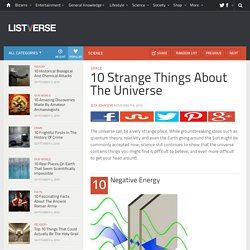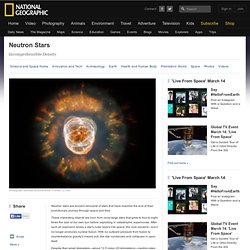

What the hell were we thinking? Brief Answers to Cosmic Questions. 10 Strange Things About The Universe. Space The universe can be a very strange place.

While groundbreaking ideas such as quantum theory, relativity and even the Earth going around the Sun might be commonly accepted now, science still continues to show that the universe contains things you might find it difficult to believe, and even more difficult to get your head around. Theoretically, the lowest temperature that can be achieved is absolute zero, exactly ? 273.15°C, where the motion of all particles stops completely. However, you can never actually cool something to this temperature because, in quantum mechanics, every particle has a minimum energy, called “zero-point energy,” which you cannot get below. One of the properties of a negative-energy vacuum is that light actually travels faster in it than it does in a normal vacuum, something that may one day allow people to travel faster than the speed of light in a kind of negative-energy vacuum bubble.
Astronomy Picture of the Day Archive. The Elegant Universe: Pt 1. The Elegant Universe: Part 3 PBS Airdate: November 4, 2003 NARRATOR: Now, on NOVA, take a thrill ride into a world stranger than science fiction, where you play the game by breaking some rules, where a new view of the universe pushes you beyond the limits of your wildest imagination. This is the world of "string theory," a way of describing every force and all matter from an atom to earth, to the end of the galaxies—from the birth of time to its final tick, in a single theory, a "Theory of Everything.
" Our guide to this brave new world is Brian Greene, the bestselling author and physicist. BRIAN GREENE (Columbia University): And no matter how many times I come here, I never seem to get used to it. NARRATOR: Can he help us solve the greatest puzzle of modern physics—that our understanding of the universe is based on two sets of laws that don't agree? NARRATOR: Resolving that contradiction eluded even Einstein, who made it his final quest. S. BRIAN GREENE:The atmosphere was electric. S. Hubble Heritage Gallery of Images. The Scale of the Universe. IMAX - Cosmic Voyage.
Your Sky. By John Walker Welcome to Your Sky, the interactive planetarium of the Web.

You can produce maps in the forms described below for any time and date, viewpoint, and observing location. If you enter the orbital elements of an asteroid or comet, Your Sky will compute its current position and plot it on the map. Each map is accompanied by an ephemeris for the Sun, Moon, planets, and any tracked asteroid or comet. A control panel permits customisation of which objects are plotted, limiting magnitudes, colour scheme, image size, and other parameters; each control is linked to its description in the help file.
Your Sky provides three ways to view the sky with links, where appropriate, among the various presentations. Sky Map The sky map shows the entire sky as viewed from a given location at a specified time and date. Horizon Views. Interactive 3D model of Solar System Planets and Night Sky. Satellite. Hubblecast. NASA Probe Successfully Orbiting Mercury—A First. NASA made history tonight as the MESSENGER probe became the first spacecraft to orbit the tiny planet Mercury.

Launched in 2004, the MErcury Surface, Space ENvironment, GEochemistry, and Ranging mission marks the first time a craft has gone near Mercury since 1975, when NASA's Mariner 10 probe conducted flybys. (Get MESSENGER facts and figures.) For the past six and a half years MESSENGER has been maneuvering itself into an orbital path via so-called gravity assists, using the tugs from flybys of Earth, Venus, and Mercury itself to speed up and alter course. At 8:45 p.m. ET, MESSENGER performed a "burn"—essentially "riding its brakes" by firing its main thruster—to slow the spacecraft enough to be captured by Mercury's gravity.
The mission control team at the Johns Hopkins Applied Physics Laboratory in Maryland was monitoring MESSENGER's progress from 96 million miles (155 million kilometers) away. At 9:10 p.m. engineers confirmed that the burn had occurred. Mercury Probe to Fill in Blanks. Neutron Stars, Neutron Stars Information. Neutron stars are ancient remnants of stars that have reached the end of their evolutionary journey through space and time.

These interesting objects are born from once-large stars that grew to four to eight times the size of our own sun before exploding in catastrophic supernovae. After such an explosion blows a star's outer layers into space, the core remains—but it no longer produces nuclear fusion. With no outward pressure from fusion to counterbalance gravity's inward pull, the star condenses and collapses in upon itself. Despite their small diameters—about 12.5 miles (20 kilometers)—neutron stars boast nearly 1.5 times the mass of our sun, and are thus incredibly dense. Just a sugar cube of neutron star matter would weigh about one hundred million tons on Earth. A neutron star's almost incomprehensible density causes protons and electrons to combine into neutrons—the process that gives such stars their name. When they are formed, neutron stars rotate in space. Pulsing Lights.